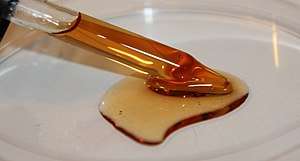''alpha''-Tocopherol
 | |
 | |
| Names | |
|---|---|
| IUPAC name
(2R)-2,5,7,8-Tetramethyl-2-[(4R,8R)-(4,8,12-trimethyltridecyl)]chroman-6-ol | |
| Identifiers | |
3D model (JSmol) |
|
| ChEBI | |
| ChEMBL | |
| ChemSpider | |
| DrugBank | |
| ECHA InfoCard | 100.000.375 |
| EC Number | 200-412-2 |
| E number | E307a (antioxidants, ...) |
PubChem CID |
|
| UNII | |
| |
| |
| Properties | |
| C29H50O2 | |
| Molar mass | 430.71 g/mol |
| Appearance | yellow-brown viscous liquid |
| Density | 0.950 g/cm3 |
| Melting point | 2.5 to 3.5 °C (36.5 to 38.3 °F; 275.6 to 276.6 K) |
| Boiling point | 200 to 220 °C (392 to 428 °F; 473 to 493 K) at 0.1 mmHg |
| Pharmacology | |
| A11HA03 (WHO) | |
| Hazards | |
| NFPA 704 | |
Except where otherwise noted, data are given for materials in their standard state (at 25 °C [77 °F], 100 kPa). | |
| Infobox references | |
α-Tocopherol is a type of vitamin E. It has E number "E307". Vitamin E exists in eight different forms, four tocopherols and four tocotrienols. All feature a chromane ring, with a hydroxyl group that can donate a hydrogen atom to reduce free radicals and a hydrophobic side chain which allows for penetration into biological membranes. Compared to the others, α-tocopherol is preferentially absorbed and accumulated in humans.[2]
Stereoisomers of alpha-tocopherol
There are three stereocenters in alpha-tocopherol, so it is a chiral molecule.[3] The eight stereoisomers of α-tocopherol differ the configuration on these stereocenters. RRR-α-tocopherol is the natural one.[4] Older name of RRR-α-tocopherol is d-α-tocopherol, but this d/l naming should be no longer used, because it is not clear whether l-α-tocopherol should mean SSS enantiomer or the SRR diastereomer, from historical reasons. The SRR may be named 2-epi-α-tocopherol, the diastereomeric mixture of RRR-α-tocopherol and 2-epi-α-tocopherol may be called 2-ambo-α-tocopherol (formerly named dl-α-tocopherol). The mixture of all eight diastereomers is called all-rac-α-tocopherol[5]
One IU of tocopherol is defined as ⅔ milligrams of RRR-α-tocopherol (formerly named d-α-tocopherol, or sometimes ddd-α-tocopherol). 1 IU is also defined as 1 milligram of an equal mix of the eight stereoisomers, which is a racemic mixture, all-rac-α-tocopheryl acetate. This mix of stereoisomers is often called dl-α-tocopheryl acetate. However, 1 IU of this mixture of diastereomers is not now considered equivalent to 1 IU of natural RRR-α-tocopherol, and the Institute of Medicine and the USDA now convert IU's of the racemic mixture to milligrams of equivalent RRR using 1 IU racemic mixture = 0.45 "milligrams α-tocopherol".[6]
See also
References
- ↑ Merck Index, 11th Edition, 9931.
- ↑ Rigotti A (2007). "Absorption, transport, and tissue delivery of vitamin E". Mol. Aspects Med. 28 (5–6): 423–36. doi:10.1016/j.mam.2007.01.002. PMID 17320165.
- ↑ Jensen SK, Lauridsen C (2007). "Alpha-tocopherol stereoisomers". Vitam. Horm. 76: 281–308. doi:10.1016/S0083-6729(07)76010-7. PMID 17628178.
- ↑ Brigelius-Flohé R, Traber MG (1 July 1999). "Vitamin E: function and metabolism". FASEB J. 13 (10): 1145–55. doi:10.1096/fasebj.13.10.1145. PMID 10385606.
- ↑ IUPAC Nomenclature of Tocopherols and Related Compounds
- ↑ "Composition of Foods Raw, Processed, Prepared USDA National Nutrient Database for Standard Reference, Release 20" (PDF). USDA. February 2008. Archived from the original (PDF) on 2012-02-19.
